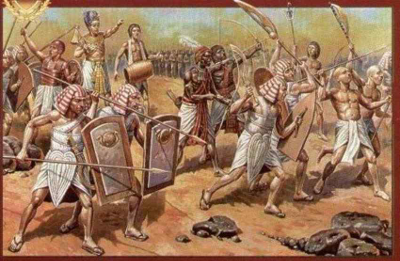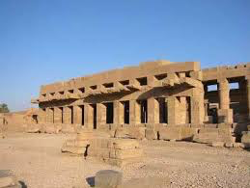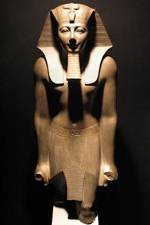Thutmose III: the 'Napoleon of Egypt'
Thutmose III's mother was Iset, another of Thutmose II's wives. Hatshepsut arranged a top-notch education for her young stepson, as he grew up at the royal court of Thebes. He underwent military training, first and foremost, but also learned the arts of running a kingdom. He proved adept at archery, hand-to-hand combat, and horsemanship. When he came of age, Hatshepsut named him head of her armies. 
Hatshepsut ruled for 22 years. When she died, in 1458 B.C., Thutmose III became king all by himself. A change in leadership often brought with it challenges from within and without. In this case, Thutmose III had to put down rebellions in the east, specifically with the civilizations in Canaan and Syria. His first big test was the Battle of Megiddo, in which he led his troops to a smashing victory over the Canaanites and the Mittani. It was the first of 17 campaigns on which Thutmose III set out, at the head of his armies. He claimed successes on battlefields in Israel, Lebanon, Mesopotamia, Nubia, and Palestine as well. He was strong and skilled in fighting and in military tactics. He was so successful, defeating so many of his enemies so many times, that many historians have named him "the Napoleon of Egypt." He knew well the No records exist that tell of his losing in battle. He is said to have conquered 350 cities. He was also known as being a benevolent ruler, treating the people he conquered with respect (as long as they acquiesced to his rule). 
Thutmose III also commissioned a large amount of construction throughout his realm. Historians know of more than 50 temples that he ordered built. Obelisks and monuments ordered built by him dotted the countryside. He also had constructed several additions to the massive Temple of Karnak at Thebes. An early appreciator of the arts, he continued this trend while on the throne, ordering the development of public gardens and parks and installing a private garden at both the royal palace and at Karnak. At the same time, he ordered his stepmother's name to be erased from many monuments, including her mortuary temple at Deir el-Bahri, and had monuments dedicated to her replaced with monuments dedicated to him. As was the custom, he had several wives. He was the father of nine children. He ruled for 54 years in all, 32 years by himself. He died in 1425 B.C., and his body was preserved in a well constructed and long planned tomb in the Valley of the Kings. Succeeding him on the throne was Amenhotep II, who had already served as co-regent for two years. |
|
Social Studies for Kids
copyright 2002–2025
David White



 Thutmose III was one of Egypt's most famous and militarily successful pharaohs. He was the only son of Thutmose II, who himself spent 14 years on the throne of Egypt. Thutmose II died in 1479 B.C., when his young son was just 2. The queen at the time,
Thutmose III was one of Egypt's most famous and militarily successful pharaohs. He was the only son of Thutmose II, who himself spent 14 years on the throne of Egypt. Thutmose II died in 1479 B.C., when his young son was just 2. The queen at the time,  value of a surprise attack and the importance of maintaining a reliable supply line; and, as evidence on the way to Megiddo, he was not afraid of taking dangerous chances. His successes were wide and wide-ranging, extending the boundaries of Egypt-controlled territory farther than ever before. His conquests and trade filled the royal coffers to their highest levels in several hundred years.
value of a surprise attack and the importance of maintaining a reliable supply line; and, as evidence on the way to Megiddo, he was not afraid of taking dangerous chances. His successes were wide and wide-ranging, extending the boundaries of Egypt-controlled territory farther than ever before. His conquests and trade filled the royal coffers to their highest levels in several hundred years.
